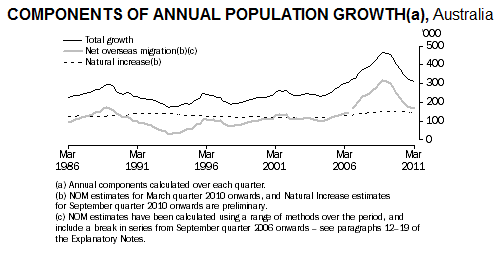Kevin Rudd’s political career was over when he uttered the words ‘big Australia’. Dick Smith, the hobby pilot and millionaire political agitator, took it upon himself to raise the profile of the population debate, making it the Australian identity crisis of 2010. Many economic commentators came out in support of the high rate of population growth, citing the increasing age dependency ratio as a critical issue that population growth, and high rates of immigration in particular, could address.
The public debate, however, was about three years behind the statistics. The graph below shows that the rate of population growth in Australia peaked in late 2008 (at 2.2%), and was already on its way down to the historical average of 1.4% where is currently sits.
Unlike many economists, I have a different opinion on the age dependency ratio. I see it as a shining beacon of success. People are working for shorter periods of their life. We as a group are finally taking some of our productivity gains of the past half-century in the form of leisure time, albeit in our twilight years.
Australia’s age dependency ratio is 16th out of this comparison of 20 developed nations – none of whom appear to be in a hurry to stimulate population growth to ‘solve’ this problem. Sweden, Norway, UK, USA, Denmark, Germany and Canada all appear to cope quite well with their demographic fortunes. Our culture, financial structures and welfare system, are still adapting to a population pyramid becoming more cylindrical.
But whether or not you agree that the age dependency ratio is a problem, the suggested solution of population growth is, in reality, counterproductive, and will only aggravate the situation.
An increase in the age dependency ratio is principally the result of improving longevity. If each generation lives longer than the last we will face this problem even with a growing population. Simply adding more at the bottom of the population pyramid to keep it bigger than the top has the apt label ‘population Ponzi scheme’.
Indeed, to counteract this trend would require a perpetually increasing birth rate, age biased migration policies, or even the extreme scenario of sending migrants home at age 65. To me, none of these are desirable.
Notably, the side of the debate promoting greater immigration are mostly vested business interests. Businesses facing demand saturation limits per person (a single person can only consume one of the same newspaper per day, or a finite amount of food) and are limited to domestic consumption (which foreigners are interested in Australian newspapers) have the most to gain from population growth.
Luckily age dependency argument in favour of population growth was put to rest by the Productivity Commission, when it published a research paper published in December last year.
In sum, realistic changes in migration levels are unlikely to make a substantial difference to the age structure of Australia’s population in the future, and any effects are likely to be temporary. Realistic changes to fertility could have some effect in the long term, but the proportion of older Australians will still grow from current levels. Increased longevity (a desirable trend!) is the dominant force.
Overcoming age dependency is not an option. Regardless of whether retirees self-fund or are supported via the welfare system, the economic impact arises simply from their non-participation in the workforce. Therefore accommodating an aging demographic is the way forward.
While the Australian government is incrementally increasing the qualifying age for the age-pension to 67 by 2023, potentially offsetting dependency concerns, I expect other adaptations to naturally occur:
- People will spread their work time over the life much better, possibly taking intermittent retirements between careers.
- Part-time jobs will become expected even in senior positions, as the highly experienced workforce phases down to retirement.
- Productivity of the workforce will gradually improve.
- The population aged under 15, who are also dependent, will shrink as a fertility rates decline from the current heights of the baby boomer ‘echo’ (the grandchildren of boomers).
As we adapt to an ageing demographic, the questions we need to ask are about how best to utilise our new labour force structure. We don’t need the debate hijacked by vested interestes arguing for population growth.
Tips, suggestions, comments and requests to [email protected] + follow me on Twitter @rumplestatskin
